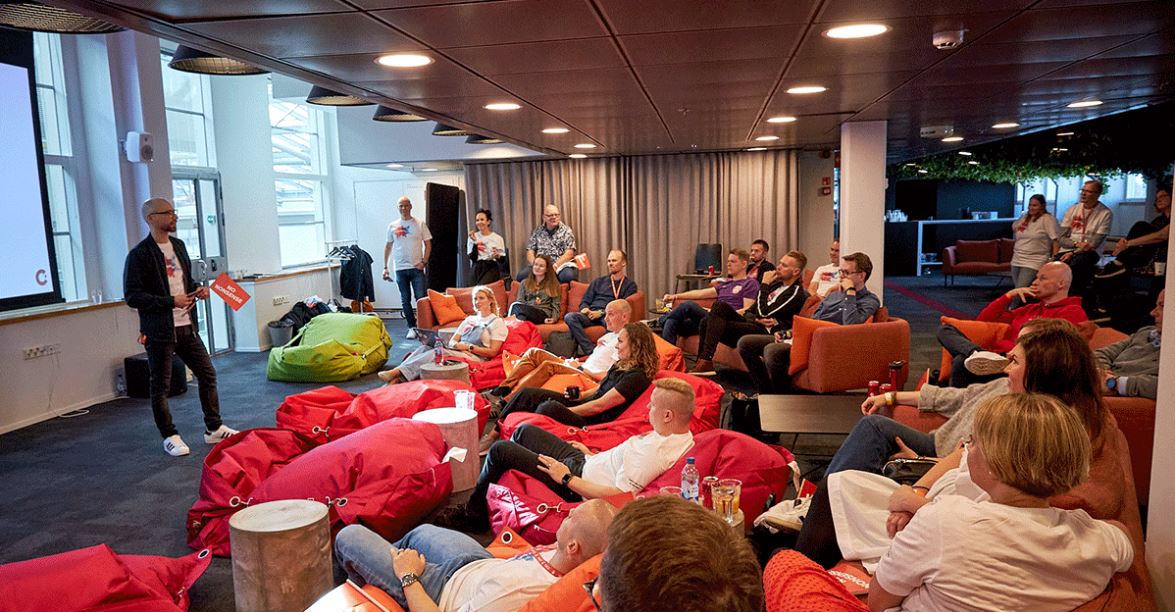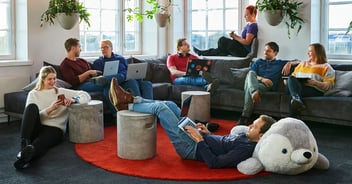Enjoyable office spaces and factors that affect attractiveness
Quick, easy and inexpensive options:
Events. Welcome everyone back to the office with brunch, coffee and cake, a champagne toast, after-work drinks or other events. Choose something you know your people like, something they miss doing, something that makes them happy. Now is the time to craft the new normal into something completely different than the monotonous stay-at-home routines of the past, so build some transition rites to highlight the change. Set up your own “fun squad” for everyone to join, a group that comes together to plan social events, ensuring that the people who have traditionally organized those events aren’t alone in making decisions about shared leisure activities. Go to town setting the right mood and energy of the first events and get-togethers. These will help people invest in the community and give them a reason to come to the office, even during the colder and darker months of the year. Try to strike the right balance when it comes to the number of events and their variety; organizing too many will result in fewer people attending each.
Workout/hobby groups. Set up a weekly visit to the gym, office yoga sessions or a bicycle commute race to get people up and about on a regular basis and to address the potential problems caused by office ergonomics. If exercising as a group isn’t your team’s thing, set up weekly board game nights or watch parties for favorite TV shows.
A peaceful work environment and good ergonomics. Set up quiet work spaces at your office and establish some ground rules around things like appropriate times to take video calls at the desk. If background noise hinders concentration, try noise-cancelling headphones. Make sure your office ergonomics are top-notch. Many people come to the office so they can use a proper workstation and get away from the noise and mess of working from home.
Cleaning as a group. Organize group cleaning sessions to get rid of unsightly stacks of unnecessary things. You can even order pizza to help make the whole thing enjoyable and social. Yes, after spending so much time at home, even cleaning can feel like a party!
Snacks. Make sure fruit and other healthy snacks are always available.
Hygiene. Improve your cleaning processes in line with official recommendations for office spaces, and make sure masks and hand sanitizer are always available.
More involved (but still worthwhile!) ideas:
Functionality review of your spaces. Make sure that you have enough small conference rooms and phone booths. Renovate, or buy some furnishings if necessary. Even small changes can make a world of difference when it comes to improving your office. If your space doesn’t meet the needs of your work and can’t be renovated at a reasonable price, consider moving. There’s no point paying for empty, non-functional spaces that don’t support your work or help you maintain a good community. Without an enjoyable office space, people will stay holed up at home unless ordered otherwise, and encouraging them to come to the office will become harder and harder.
Flexible workstations and teamwork spaces. If people continue to work remotely, consider making your office more mobile. For many organizations, this is easier and more feasible than ever. (More information about our VincitFlex™ workstations and project spaces, currently being tried out at larger offices can be found at the end of this article.*) Build spaces that are well suited to team meetings using input from the people you work with, and seek professional design help if necessary..
Audiovisual equipment. Make sure all your audiovisual equipment is in good working order and ready for hybrid work. Don’t hesitate to get any additional equipment you may need for spaces like work cafés. This provides everyone with a chance to hear and see life outside conference rooms, regardless of where they’re working.
Meetings, training and individualized support
Scheduling time for people. If you’re a supervisor or your job includes helping people and taking an interest in their everyday lives, make space in your schedule for meetings and plan some flexible time into your office days. Grab your laptop and find a place where people can come and speak to you. And don’t forget to regularly contact people who are working entirely from home. If your workplace has lots of people, keep track of the last time you talked to each person. Time flies, and the growing distance can take you by surprise.
Training for individuals. Offer training to help people get the most out of hybrid work and apply change management to their everyday lives. Encourage people to build a working week that suits them and helps their team work well together. Collaborate with your business partners. At Vincit, we’re supported by our low-threshold mental well-being service Auntie and our occupational health care partner Heltti, the latter of which helps us create webinars to support everyday life and work. Additionally, we offer all our employees Academy of Brain’s 25-part hybrid work-study path based on microlearning. The study path is a series of 3–5-minute videos plus texts that delve deeper into the subjects covered in the videos. People can go through the materials independently or as a group, during separate morning or afternoon coffee sessions at the office.
Individual choices. Respect people’s views and choices when it comes to vaccinations and remote working. Try to find the work practices that best serve the whole team on a day-to-day basis and that take people’s different life situations and conditions into account. Think carefully about whether it’s actually necessary to immediately demand 100% office attendance from everyone if sufficient communication is achievable without it.
Into the new normal—brave but patient, and with respect for authenticity
The human brain reacts to change slowly, and it’s worth taking your time transitioning to hybrid work (or, especially, to full office attendance)—even if most people are eager and excited to take the leap. Now is an excellent time to think carefully about what work practices, times and places work best for you. It’s also worth considering which good practices you may want to carry over from the time you spent working remotely. Try increasing the number of office days gradually, and question your own experiences of things, for example, how much strain in-person contact exerts. We know from experience that it’s easy to stay home (no time wasted commuting, the ability to sleep until five minutes before your first meeting, easy-to-coordinate family life and hobbies, etc.), but meeting colleagues face-to-face can be better for us than we expect. For further inspiration, look to this blog post written by Vincit’s former board member Kirsi Piha. Sometimes, persevering and convincing your colleagues to get together in a physical location can be a good idea, even if they’re reluctant to do so at first.
So let’s bravely challenge our remote working routines and give working from the office a go, even if we aren’t strictly required to. If it makes you more comfortable, put on your familiar sweatpants and hoodie, let your bedhead go untamed and start with just a few short visits to the office. Humanity, authenticity and a smooth, natural work-life balance are the best things we can bring with us to the new normal, regardless of where we choose to work.
* At Vincit, we are building VincitFlex™ workstations and project spaces to combat desolate offices and allow teams to easily book a space for their shared office day or workshop. In addition to chairs and electric standing desks, VincitFlex™ workstations include a standardized set of accessories that are compatible with both PC and Mac (the availability and installation of which our IT Support Team regularly takes care of in cooperation with your personnel).
VincitFlex™ workstations don’t lack cables or components—everything is always easily available—and places for personal belongings are available to anyone who wants them. Additionally, if employees want to give up their fixed workstation and work at a VincitFlex™ workstation while at the office, they can equip their home office with corresponding hardware of their choice at Vincit’s expense.




